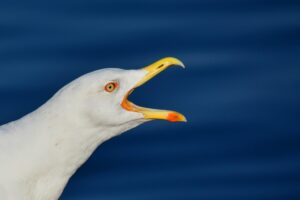Aspects Of The Seagull Are Unique.
Aspects Of The Seagull Are Unique: An example of a coastal bird, the seagull lives along the coast and is one of the world's most persistent and skilled gatherers.
There are about 50 known species found throughout the world. The most well-known species are the European and American Herring Gulls, but the entire family is quite diverse.
This page will teach fascinating facts about the gull's appearance, behaviour, and food.
Eagle vs gull
Gulls have some superficial similarities to eagles, such as a big body and hooked beak. However, they are not considered birds of prey. They are more closely related to alcids, plovers, and other shorebirds than eagles, kites, and vultures.
Amazing facts about gulls!
The gull is regarded as one of the most intelligent birds on the planet. Some birds tear open a mussel shell by dropping it on a rock. Other people have been seen baiting fish with bread.
One of the most remarkable things about gulls is that they can recall new food-finding tactics gulls pass on their knowledge to the next generation..
Gulls, unlike most animals, can drink both fresh and saline water. The salt can be collected by a specific gland immediately above the eyes and then flushed out through the nostrils.
Gulls have a tiny claw halfway up their lower leg to perch on high ledges without slipping off.
Where can I find the gull?
Most gulls live along the coast, particularly in the northern hemisphere.
During the non-breeding season, some gulls migrate further inland but remain near the coastlines.
Nests of gulls
Most gulls build their nests in a deep depression in the ground (or on cliffs) out of plants, feathers, rope, and even plastic.
It is frequently placed near a rock, log, or bush to protect the nest from predators.
The gull's scientific name
Laridae is the scientific name for the gull family. It is taken from the Latin word for a seabird, Larus.
Dimensions, look, and behaviour.
Gulls can be identified by their enormous, massive bodies, sinewy legs, lengthy wings, and powerful beaks that culminate in a hook.
Their bodies are usually coated in white, grey, or even black plumage, although the colour of the head varies by species. While American and European herring gulls have white heads, certain species, such as Franklin's Gull, Lesser Black-backed Gull, and Swallow-tailed Gulls, have blackheads.
During the winter, the head plumage often turns mottled grey (or, if initially black, white). Gulls can range from 11 to 30 inches from head to tail, depending on the species.
Gulls are found in loose, dispersed colonies along the shore. The colony may consist of a few pairs or thousands of birds.
Breeding pairs stay in their territory and protect it from intruders, although they also congregate to hunt and graze. Foraging is a noisy activity that requires constant movement and noise.
Each bird essentially fights for its survival. They frequently take food from other animals and one another.
Gulls use a variety of cries to demonstrate hostility, identify mating partners, warn the colony of a threat, and settle territorial disputes.
Chicks will also beg their parents for food.
Timing and migration patterns
During the winter, the majority of gull species move south. Some birds migrate only a few kilometres in pursuit of better feeding grounds, while others travel thousands.
The Franklin's Gull, migrating from Canada to South America every year, may make the longest journey.
Diet
The majority of gulls are carnivores who supplement their diet with plant leftovers. They frequently hunt on anything floating on the surface of the water, beach, or land.
These courageous birds may even steal food from a human's hand.
What does the gull consume?
Gulls consume a wide variety of foods. Fish, insects, earthworms, molluscs, rodents, small reptiles and amphibians, fruits and seeds, and even other birds and their eggs make up their diet.
They hunt in the same areas every day or soar high into the air and dive to get their prey. They cannot, however, dive beyond the sea's surface.
Breeding, childbirth, and moulting
The breeding season for gulls occurs in early spring, once they have returned to the exact location from their annual migration.
They usually mate for life with the same spouse and can reinforce their attachment by feeding on each other. After mating, the female produces up to three eggs each year.
For roughly a month, the parents alternate incubating the egg while the other parent forages.
One to two months after hatching, the parents feed the chicks until they have developed their complete plumage.
Compared to adult birds' solid-coloured feathers, many juvenile birds have speckled brown feathers. Sexual maturity takes several years typically.
Many species have been known to live for up to 30 years; the oldest documented example was a 49-year-old White-headed Gull.
The post Aspects Of The Seagull Are Unique appeared first on https://gqcentral.co.uk





Comments are closed